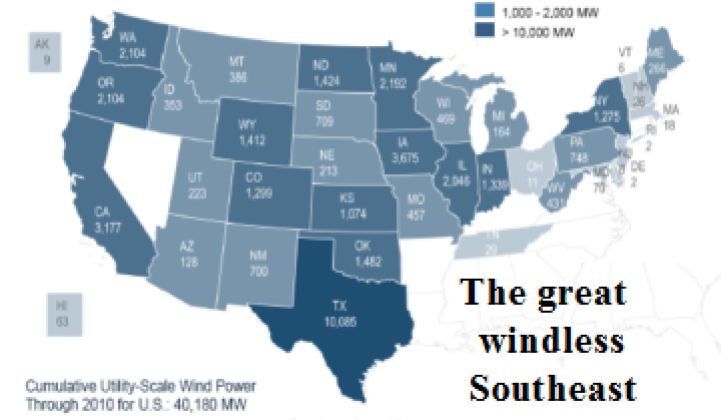The map of wind developments in the southeastern United States recalls nineteenth-century maps that labeled the U.S. West “the great American desert” and left it blank. Today’s Southeast is a blank slate in terms of wind development.
Wind Capital Group, founded by Tom Carnahan, is pioneering the territory. Having built the first wind project in Missouri after they told him it couldn’t be done, he now wants to build 150 megawatts of onshore wind power in West Palm Beach County, Florida, the first utility-scale wind project in the Southeast.
“At Wind Capital, we like to prove folks wrong when they say you can’t do something,” Carnahan said. “The stars are in alignment for a project in Florida.”
First, Carnahan said, “There are turbines now that can go to a moderate to low wind resource and very efficiently make electricity. You’re able to see good production on sites that just a few years ago would not have been viable.”
Second, because of the recession, "prices have gone down significantly,” Carnahan said. “The turbines themselves, power transformers, commodities, and the construction piece,” he said, “all of those prices have dropped. When you get decreases in prices in combination with increases in technology efficiency, you get very competitively priced energy.”
“Good for the environment, good for the economy and good for energy consumers” is the way Wind Capital Group’s Florida Project Director Robin Saiz described the proposed 150-megawatt Palm Beach County Project. It will be sited on agricultural land at the southern tip of Lake Okeechobee, west of Palm Beach and east of the Everglades, where sugar cane and tomatoes now dominate the landscape.
“We’re doing something that’s never been done,” Carnahan said of the wind farm. “When you’re doing that, the most important thing is to get in early and engage, whether it is the landowners, environmentalists, or local public officials,” he said. “Listen to what they want. We’ve been doing that, while at the same time assessing environmental concerns in this very unique area and also getting a very deep understanding of what the wind resource looks like.”
“We’ve done presentations to the landowners,” Saiz said. “There’s an education process that has to happen with wind.” Enough of the targeted 11,000 to 15,000 acres has been secured for the 84 to 100 turbine installation that Saiz says he feels confident about the project's outcome. The response, he said, has “been very favorable.”
“We don’t have Texas wind,” Saiz said, but “there is commercial-grade wind here.” The best winds in Florida are on the coast, but that area can’t be developed because Florida’s lifeblood is seashore tourism. Wind Capital Group astutely chose its site on lightly populated and just barely elevated land where turbines can catch little-dissipated inland ocean breezes and winds off Lake Okeechobee. Taller turbines and longer blades, Saiz said, make the newest turbines commercially viable, even with these less powerful winds.
“Some of the normal stuff you hear,” Saiz added of the rural location, “like ‘They’re ugly to look at’ and ‘They make a lot of noise' -- which I don’t believe they do -- in this instance are not really relevant arguments.”
Local growers are excited about extra earnings from lease agreements for small portions of land, and "they can farm right up to the access roads,” Saiz said. He has assured the farmers he will protect their topsoil. “That’s extremely critical in this area,” he said.
Saiz said the company has “a very aggressive plan” for the study of local avian habitats. “We’ve got two of the best birders in the state that we’ve got out there 52 weeks of the year, five days a week, so that we fully understand not only the presence that’s out there but also the behaviors.” The company will combine its findings with extensive previous data. “We’re using every resource that we have.”
The company, Saiz said, is determined “to do right by the community” and the response, in turn, “has been a pleasant surprise.”
Saiz does not anticipate problems with transmission. “A large transmission line runs through that area,” he said. Interconnection studies are proceeding and the company is “talking to every wholesale buyer in the state. Then we’ll determine who’s going to buy our power and we’ll enter into a power purchase agreement.”
The company’s intention is to have the project on line by the end of 2012.
In a state known for vocal activists and passionate environmentalists, Saiz said Wind Capital Group’s approach has been to engage with and solicit the concerns of as many stakeholders as possible early and transparently “so that we can work together in the process” instead of getting down to the permitting stage “and then having a fight on our hands.”
“Listening, listening, listening,” is how Carnahan described the company's approach. “There is absolutely a market,” Carnahan said of his discussions with Florida’s investor-owned utilities, municipal utilities and electric co-ops. “Utilities are big, complex organizations and they have a lot of things that are important to them,” he explained. “If a utility says there is a price range that they need, we’re going to listen to that. If they say there’s something amiss with their regulator, we’re going to listen to that. It’s all about listening to what people want and being responsive.”
Carnahan said the company will not be a “one-trick pony” in Florida and the Southeast. “We are always going to be developing and looking to get a first-mover advantage in places where we think the market forces and the community needs come together.”



